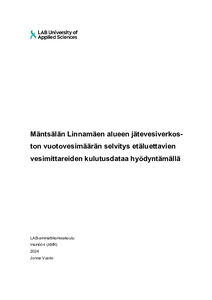Mäntsälän Linnamäen alueen jätevesiverkoston vuotovesimäärän selvitys etäluettavien vesimittareiden kulutusdataa hyödyntämällä
Vuorio, Jonna (2024)
Vuorio, Jonna
2024
All rights reserved. This publication is copyrighted. You may download, display and print it for Your own personal use. Commercial use is prohibited.
Julkaisun pysyvä osoite on
https://urn.fi/URN:NBN:fi:amk-2024120933885
https://urn.fi/URN:NBN:fi:amk-2024120933885
Tiivistelmä
Jätevesiviemäriverkoston vuotovedet ovat ympäristöstä viemäriverkostoon päätyviä pinta- tai pohjavesiä. Vuotovedet aiheuttavat ylimääräisiä kustannuksia viemäriverkostossa ja jätevedenpuhdistamolla, ja ne hankaloittavat jätevedenpuhdistusprosessia. Lisäksi vuotovesistä johtuvat ylivuodot jätevedenpumppaamoilla ja ohijuoksutukset jätevedenpuhdistamolla aiheuttavat ympäristöhaittoja. Ilmastonmuutoksen myötä sateisuus lisääntyy ja myös vuotovesimäärät tulevat lisääntymään, ellei korjaustoimenpiteisiin ryhdytä.
Opinnäytetyössä selvitettiin Mäntsälän Linnamäen alueen jätevesiviemäriverkoston vuotovesimäärää vuoden tarkastelujaksolla sekä etäluettavien vesimittareiden kulutusdatan hyödynnettävyyttä datapohjaisessa vuotovesiselvityksessä. Vuotovesiselvitystä varten ladattiin tiedot alueen vedenkulutuksesta, jätevedenpumppaamon virtaamasta ja säähavainnoista. Aineiston perusteella laskettiin alueen vuotovesiprosentti ja vuotovesimäärän vaihtelua verrattiin vallinneisiin sääolosuhteisiin. Tarkempaa tarkastelua kohdistettiin sateiselle ja sateettomalle ajanjaksolle sekä lumen sulamisen ajanjaksolle.
Alueen vuotovesiprosentti on tulosten perusteella 23,7 % jäteveden kokonaismäärästä. Vuotovesimäärät lisääntyvät sateisena ajanjaksona ja lumen sulaessa. Samanaikainen vesisade nopeuttaa lumen sulamista ja kasvattaa vuotovesimäärää. Alueen vuotovedet päätyvät viemäriin nopeasti vuotavina vesinä sekä suotautuvina vuotovesinä. Alueen verkostossa on vuotavia putkia ja liitoksia, mutta vuotokohtien ja mahdollisten virheellisten tai laittomien kiinteistöjen hulevesiputkien liitosten paikantamiseksi tarvitaan tarkempia tutkimuksia. Etäluettavien vesimittareiden kulutusdatan avulla saadaan tarkkaa tietoa alueen vedenkulutuksesta ja sen vaihteluista, mikäli niitä on asennettu alueelle kattavasti. Infiltration and inflow of extraneous water (I/I water) in the wastewater sewer network can be defined as surface water or groundwater that enters the sewer network. I/I water causes additional costs in the sewer network and at the wastewater treatment plant and complicates the wastewater treatment process. Great amounts of I/I water can also lead to overflows at wastewater pumping stations and bypasses at the wastewater treatment plant and these cause environmental problems. With climate change, rainfall will increase, and the volume of I/I water will also grow unless corrective measures are taken.
This thesis assessed the amount of I/I water in the wastewater sewer network of the Mäntsälä Linnamäki area over a one-year period, as well as the applicability of remotely readable water meter consumption data in a data-driven I/I water study. The study utilized remotely readable water meter consumption data, wastewater pumping station flow data, and weather observations. Based on the data, the I/I water percentage for the area was calculated, and the variations in I/I water volumes were compared to the prevailing weather conditions. A more detailed analysis focused on rainy and non-rainy periods as well as the snowmelt period.
According to the results, the I/I water percentage in the area is 23,7% of the total wastewater volume. I/I water volumes increase during rainy periods and snowmelt. Simultaneous rainfall accelerates snowmelt and increases I/I water volumes. I/I water ends up in the sewer system as rapidly leaking water and seepage infiltration water. There are leaking pipes and connections in the network, but more detailed inspections are needed to locate the leakage points and possible erroneous or illegal stormwater pipe connections from properties. Remotely readable water meter consumption data provides accurate information on water usage and its variations in the area, if installed comprehensively in the area.
Opinnäytetyössä selvitettiin Mäntsälän Linnamäen alueen jätevesiviemäriverkoston vuotovesimäärää vuoden tarkastelujaksolla sekä etäluettavien vesimittareiden kulutusdatan hyödynnettävyyttä datapohjaisessa vuotovesiselvityksessä. Vuotovesiselvitystä varten ladattiin tiedot alueen vedenkulutuksesta, jätevedenpumppaamon virtaamasta ja säähavainnoista. Aineiston perusteella laskettiin alueen vuotovesiprosentti ja vuotovesimäärän vaihtelua verrattiin vallinneisiin sääolosuhteisiin. Tarkempaa tarkastelua kohdistettiin sateiselle ja sateettomalle ajanjaksolle sekä lumen sulamisen ajanjaksolle.
Alueen vuotovesiprosentti on tulosten perusteella 23,7 % jäteveden kokonaismäärästä. Vuotovesimäärät lisääntyvät sateisena ajanjaksona ja lumen sulaessa. Samanaikainen vesisade nopeuttaa lumen sulamista ja kasvattaa vuotovesimäärää. Alueen vuotovedet päätyvät viemäriin nopeasti vuotavina vesinä sekä suotautuvina vuotovesinä. Alueen verkostossa on vuotavia putkia ja liitoksia, mutta vuotokohtien ja mahdollisten virheellisten tai laittomien kiinteistöjen hulevesiputkien liitosten paikantamiseksi tarvitaan tarkempia tutkimuksia. Etäluettavien vesimittareiden kulutusdatan avulla saadaan tarkkaa tietoa alueen vedenkulutuksesta ja sen vaihteluista, mikäli niitä on asennettu alueelle kattavasti.
This thesis assessed the amount of I/I water in the wastewater sewer network of the Mäntsälä Linnamäki area over a one-year period, as well as the applicability of remotely readable water meter consumption data in a data-driven I/I water study. The study utilized remotely readable water meter consumption data, wastewater pumping station flow data, and weather observations. Based on the data, the I/I water percentage for the area was calculated, and the variations in I/I water volumes were compared to the prevailing weather conditions. A more detailed analysis focused on rainy and non-rainy periods as well as the snowmelt period.
According to the results, the I/I water percentage in the area is 23,7% of the total wastewater volume. I/I water volumes increase during rainy periods and snowmelt. Simultaneous rainfall accelerates snowmelt and increases I/I water volumes. I/I water ends up in the sewer system as rapidly leaking water and seepage infiltration water. There are leaking pipes and connections in the network, but more detailed inspections are needed to locate the leakage points and possible erroneous or illegal stormwater pipe connections from properties. Remotely readable water meter consumption data provides accurate information on water usage and its variations in the area, if installed comprehensively in the area.
